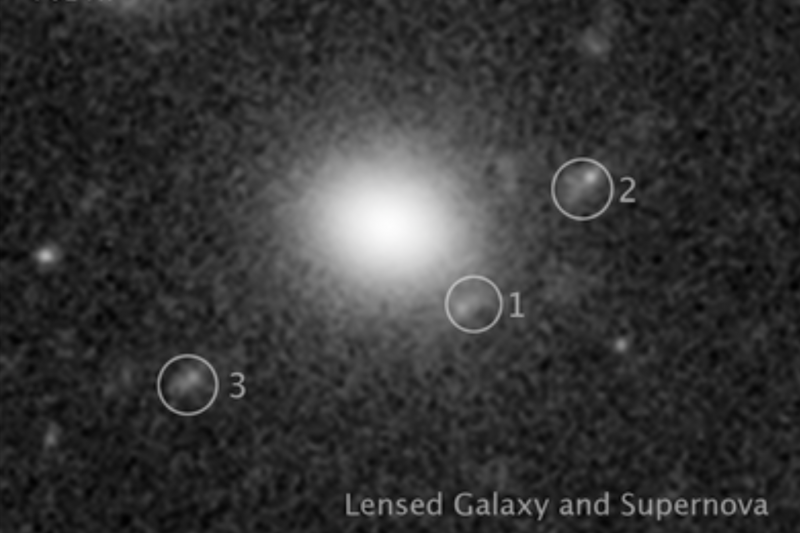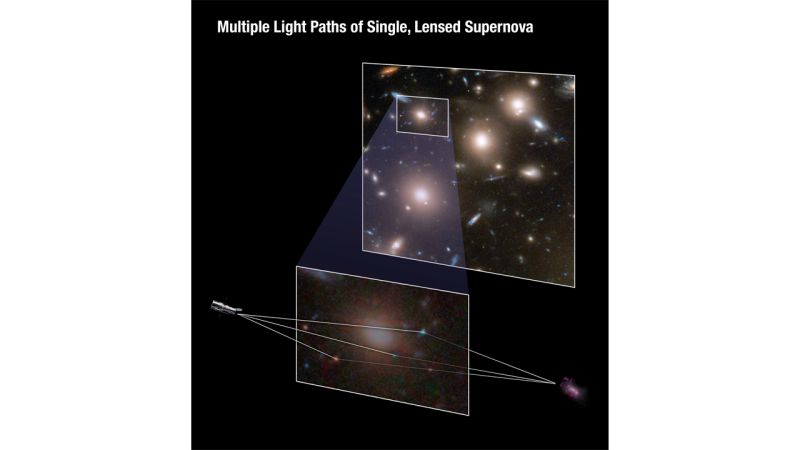
One supernova at 3 different times
Here’s a strange one. Hubblesite said this week (November 9, 2022) that the Hubble Space Telescope has captured a single image of a supernova – or exploding star – at three different points in the explosion. How can that be?
The supernova is very far away, so far that its light left it some 11 billion years ago. We can see it only because an enormous galaxy cluster lies between us and it. The galaxy cluster’s powerful gravity is acting as a gravitational lens in space. It’s created a warp in space that has bent and magnified the supernova’s light, causing it to travel to us on three different paths, some longer and some shorter. And, in space, distance = time. So we’re seeing some light from the supernova from farther back in time … and some from closer in time.
It’s like one image containing three “snapshots” of this supernova, from three different times. These astronomers said we’re seeing this ancient star explosion as it evolved over time. Wow!
What makes a gravitational lens?
The giant galaxy cluster that acts as a lens is called Abell 370. In according with Albert Einstein’s theory of general relativity, mass causes space to curve. And so this great cluster creates a domain of curved space around itself. The larger the mass, the greater the curvature of space. As Hubblesite explained:
The later images [of the supernova] were delayed due to taking a longer route across ‘valleys’ of warped space.
The peer-reviewed journal Nature published the team’s paper on this supernova and its strange path(s) through space on November 10.

Seeing the supernova evolve
These astronomers said this is our first detailed look at a supernova so early in the universe’s history. And they’re thrilled with the images, because they show the early stages of a star explosion. The lead author of the study – astronomer Wenlei Chen of the University of Minnesota School of Physics and Astronomy – said:
It is quite rare that a supernova can be detected at a very early stage, because that stage is really short. It only lasts for hours to a few days, and it can be easily missed even for a nearby detection. In the same exposure, we are able to see a sequence of the images, like multiple faces of a supernova.
Three images, three different colors
The Hubble exposure also captured the fading supernova’s rapid change of color, which indicates temperature change. The bluer the color means the hotter the supernova is. The image of the earliest phase appears blue. As the supernova cooled, its light turned redder. Astronomer Patrick Kelly of the University of Minnesota’s School of Physics and Astronomy said:
You see different colors in the three different images. You’ve got the massive star, the core collapses, it produces a shock, it heats up, and then you’re seeing it cool over a week. I think that’s probably one of the most amazing things I’ve ever seen!
These astronomers also told how they were able to measure the size of the dying star in the early universe that created the supernova. This measurement – the first of its kind – derived from the supernova’s brightness and rate of cooling, both of which depend on the size of the progenitor star.
Hubble observations show that the red supergiant whose supernova explosion the researchers discovered was about 500 times larger than the sun.
How did they notice it?
Chen, Kelly, and an international team of astronomers described how they found this supernova by sifting through the Hubble data archives. They were looking for what are called transient events. Chen wrote machine-learning algorithms to find these events. They looked through a lot of data, but this was the only multiply-imaged supernova they found.
Chen and Kelly added that they both have time planned for NASA’s James Webb Space Telescope to observe even more distant supernovae. They hope to contribute to a catalog of very far-off supernovae to help astronomers understand if the stars that existed many billions of years ago are different from those in the nearby universe.

Bottom line: Astronomers used the Hubble Space Telescope to see one supernova at three different times in cosmic history. The key was the powerful gravity of a giant intervening galaxy cluster.
Source: Shock cooling of a red-supergiant supernova at redshift 3 in lensed images











